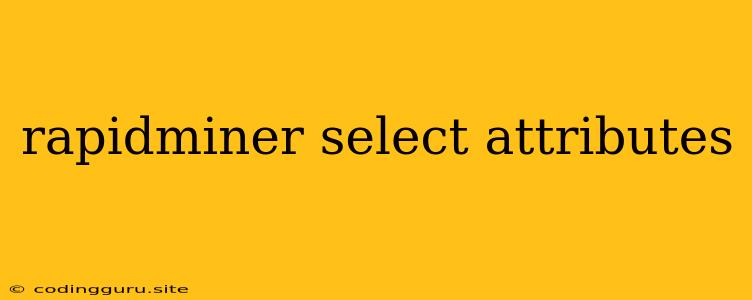Selecting the Right Features: A Guide to Attribute Selection in RapidMiner
RapidMiner is a powerful data science platform that offers a plethora of tools for building predictive models. One crucial step in this process is attribute selection, a technique that helps identify the most relevant features for your model.
Why is attribute selection important?
- Improved Model Performance: Irrelevant or redundant features can introduce noise and complexity, hindering your model's accuracy and efficiency. By focusing on the most pertinent attributes, you can achieve a more streamlined and effective model.
- Reduced Complexity: A smaller set of features simplifies your model, making it easier to understand, interpret, and deploy.
- Enhanced Efficiency: With fewer features, your model requires less computational power, leading to faster training and prediction times.
Understanding Attribute Selection Methods in RapidMiner
RapidMiner provides a wide range of attribute selection methods, each with its strengths and weaknesses. Let's explore some of the most commonly used techniques:
Filter Methods:
- Information Gain: This method measures the reduction in uncertainty about the target variable after considering a particular attribute. Higher information gain indicates a stronger relationship with the target.
- Chi-Square: This statistical test assesses the independence of attributes. Features with a significant chi-square value are considered more relevant.
- Correlation-Based Feature Selection (CFS): This method evaluates the merit of a subset of features based on its correlation with the target variable and the inter-correlation among the selected features.
Wrapper Methods:
- Forward Selection: This greedy algorithm starts with an empty feature set and gradually adds attributes one by one, choosing the feature that maximizes model performance.
- Backward Elimination: This method begins with all features and iteratively removes the least significant feature until a satisfactory model is achieved.
- Recursive Feature Elimination (RFE): This technique involves training the model with all features, then eliminating the least important feature based on its weights or coefficients. This process is repeated until the desired number of features is reached.
Embedded Methods:
- Lasso Regression: This method introduces a penalty term to the regression model, forcing some feature coefficients to become zero. This effectively eliminates irrelevant features during the model training process.
- Random Forest: This ensemble technique builds multiple decision trees and averages their predictions. Feature importance can be derived from the contribution of each attribute to the model's accuracy.
Choosing the Right Method for Your Task
The choice of attribute selection method depends heavily on the characteristics of your data and the specific goals of your project.
- Data Size: For large datasets, filter methods are typically faster and more scalable than wrapper methods.
- Feature Complexity: If you have a high number of features, embedded methods like Lasso Regression or Random Forest can be effective in identifying the most relevant features.
- Model Performance: Wrapper methods can be more accurate in selecting the optimal feature subset, but they require more computational resources.
Implementing Attribute Selection in RapidMiner
RapidMiner makes attribute selection easy with its intuitive interface. You can find several operators in the "Operators" tab specifically designed for feature selection.
- Choose your desired attribute selection method: Select the appropriate operator for your chosen technique, e.g., "Information Gain" for a filter method.
- Configure the operator: Specify the parameters for the chosen method, such as the number of features to select.
- Connect the operator: Connect the operator to your data and target variable.
- Execute the process: Run the process to perform attribute selection.
- Analyze the results: Examine the selected features and their impact on your model's performance.
Examples and Use Cases
Let's look at some real-world scenarios where attribute selection plays a vital role:
- Medical Diagnosis: Identifying the most relevant symptoms and medical history data for predicting disease outcomes.
- Customer Churn Prediction: Selecting key customer characteristics to anticipate customer churn and implement retention strategies.
- Image Classification: Extracting the most discriminative features from image pixels for accurate image classification tasks.
Tips and Best Practices
- Start with an exploratory analysis: Understand your data and its relationships before applying attribute selection methods.
- Use a validation set: Evaluate the selected features on an unseen dataset to assess their generalization performance.
- Iterate and refine: Experiment with different attribute selection techniques and parameters to find the optimal combination.
- Document your process: Record the selected features and the chosen method for reproducibility and transparency.
Conclusion
Attribute selection is a crucial step in building accurate and efficient predictive models. By employing the right methods and techniques, you can identify the most relevant features for your model, leading to improved performance, reduced complexity, and enhanced efficiency. RapidMiner's extensive suite of operators makes implementing attribute selection a straightforward process, empowering you to build sophisticated data science solutions.
